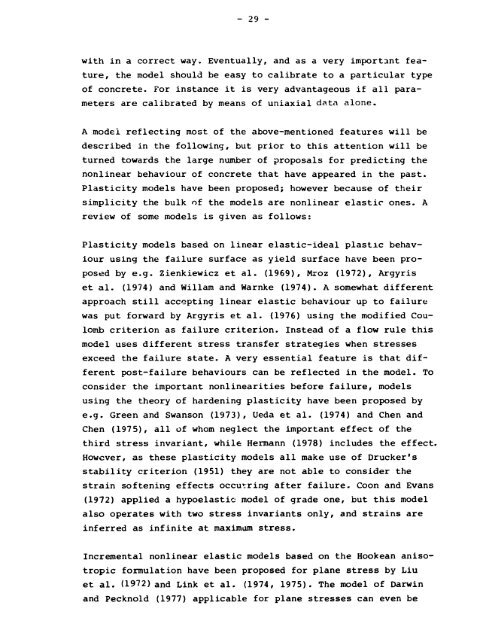Nonlinear Finite Element Analysis of Concrete Structures
Nonlinear Finite Element Analysis of Concrete Structures
Nonlinear Finite Element Analysis of Concrete Structures
You also want an ePaper? Increase the reach of your titles
YUMPU automatically turns print PDFs into web optimized ePapers that Google loves.
- 29 -<br />
with in a correct way. Eventually, and as a very important feature,<br />
the model should be easy to calibrate to a particular type<br />
<strong>of</strong> concrete. For instance it is very advantageous if all parameters<br />
are calibrated by means <strong>of</strong> uniaxial data alone.<br />
A model reflecting most <strong>of</strong> the above-mentioned features will be<br />
described in the following, but prior to this attention will be<br />
turned towards the large number <strong>of</strong> proposals for predicting the<br />
nonlinear behaviour <strong>of</strong> concrete that have appeared in the past.<br />
Plasticity models have been proposed; however because <strong>of</strong> their<br />
simplicity the bulk <strong>of</strong> the models are nonlinear elastic ones. A<br />
review <strong>of</strong> some models is given as follows:<br />
Plasticity models based on linear elastic-ideal plastic behaviour<br />
using the failure surface as yield surface have been proposed<br />
by e.g. Zienkiewicz et al. (1969), Mroz (1972), Argyris<br />
et al. (1974) and Willam and Warnke (1974). A somewhat different<br />
approach still accepting linear elastic behaviour up to failure<br />
was put forward by Argyris et al. (1976) using the modified Coulomb<br />
criterion as failure criterion. Instead <strong>of</strong> a flow rule this<br />
model uses different stress transfer strategies when stresses<br />
exceed the failure state. A very essential feature is that different<br />
post-failure behaviours can be reflected in the model. To<br />
consider the important nonlinearities before failure, models<br />
using the theory <strong>of</strong> hardening plasticity have been proposed by<br />
e.g. Green and Swanson (1973), Ueda et al. (1974) and Chen and<br />
Chen (1975), all <strong>of</strong> whom neglect the important effect <strong>of</strong> the<br />
third stress invariant, while Hermann (1978) includes the effect.<br />
However, as these plasticity models all make use <strong>of</strong> Drucker's<br />
stability criterion (1951) they are not able to consider the<br />
strain s<strong>of</strong>tening effects occurring after failure. Coon and Evans<br />
(1972) applied a hypoelastic model <strong>of</strong> grade one, but this model<br />
also operates with two stress invariants only, and strains are<br />
inferred as infinite at maximum stress.<br />
Incremental nonlinear elastic models based on the Hookean anisotropic<br />
formulation have been proposed for plane stress by Liu<br />
et al. (1972) and Link et al. (1974, 1975). The model <strong>of</strong> Darwin<br />
and Pecknold (1977) applicable for plane stresses can even be
















